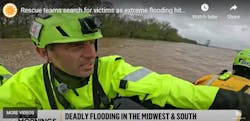In addition to rescue procedures and skills, a great deal of emphasis must be placed on self-rescue and survival procedures in cold water. If a department is dispatched to a scene where someone has fallen through the ice, it is obvious that the condition of the ice has been compromised and the danger of others being exposed to the cold water conditions is always a threat.
Cold water will rob the body of heat 25 - 30 times faster than in air. Once a person is immersed in cold water, his arms and legs become numb and useless in a very short period of time. Therefore, unless properly protected in a cold water immersion or dry suit, the ability of a victim to assist in his/her own rescue is extremely limited and will rapidly degenerate.
The inherent design of any immersion suit, water/ice rescue suit, dry suit, or any PFD with extended hypothermia protection features, is to protect the high heat-loss areas of the body, which are the top of the head, the neck, the sides of the chest, and the groin area. [PHOTO 36]
If shore-based rescue attempts are made, rescue personnel must be aware that the victim may not be able to grab onto anything extended or thrown to him. Therefore, rescue personnel must consider the victim as a passive victim. If rescue throw bags or heaving lines are tossed to the victim, the victim most likely will not be able to grab onto the line in order to be pulled from the water. But rather, the victim must be instructed to twist or wrap himself with the line before the attempt is made to pull the victim to shore.
If shore-based rescuers attempt to extend something to the victim, that device will have to snag or loop over the victim since the victim will not be able to grab or hold onto the device.
Rescue personnel crawling out over the ice must realize the strength and integrity of the ice has already been compromised and always presents the chance of cracking or breaking under the weight of the rescuer and his equipment. Should the ice give way, as the rescuer falls into the cold water, he must make a conscious effort to protect his airway by covering his mouth and nose with one hand in order to prevent him from gasping and aspirating cold water into his mouth and nose.
Once the rescuer makes contact with the victim, shore-based rescuers manning tether lines must be extremely cautious when pulling the rescuer and victim back to shore so as to not cause additional injury to the victim or the rescuer due to the ice ledge or obstructions on the ice. Predetermined hand and/or whistle signals must be established so that the rescuer can effectively communicate with the shore-based personnel manning the tether lines. [PHOTO 37]
Rescue personnel must be cognizant of the conditions of the water in terms of depth, currents, clarity, etc. If, upon arrival on the scene, the victim can no longer be seen at the surface of the water, attempts must be made to search horizontally under the ice sheet using a pike pole, as well as to probe along the bottom.
Typically, if the victim was struggling next to the ice ledge, he will be found directly below the ledge, unless there are currents. If a child is missing through the ice in a moving water environment, rescuers can place one or several bags of potatoes or onions, with a flashlight or lightstick attached, into the water and watch the movement of the bag. Wherever the bag stops is a good indication of where the child might be located.
PUBLIC EDUCATION
In order to prevent ice and cold-water related incidents, Public Safety and Rescue agencies should play an active role in public education. Ice skaters, snowmobilers, ice fishing enthusiasts, etc. should learn about the dangers of ice and should be aware of the contributing risk factors associated with on-ice activities.
These risk factors include alcohol consumption, poor ice conditions, excessive snowmobile speed, poor visibility or light conditions, etc. They should be aware of the characteristics of ice including information on ice formation and factors which affect ice strength.
Ice thickness is only one of the many factors that determine the strength and integrity of ice. Ice thickness and its strength should be checked in several places before venturing onto the ice and the strength of the ice should never be judged by its appearance alone. Ice is never 100% safe and should never be considered safe or strong enough to walk, play or travel on safely. There is always a risk involved every time you venture onto the ice.
The following principles should be adhered to at all bodies of water where recreational activities take place on or near the ice:
- Ice clouded with air bubbles should be avoided. Although it may appear as solid ice, this ice is typically weak! Ice must freeze to a uniform depth of at least four inches before it is firm enough for skating or ice fishing.
- Skaters and others should not go near partially submerged obstacles such as stumps and rocks where ice is weaker, and these dangerous areas should be clearly identified and avoided.
- Ice over moving water is probably unsafe and should be avoided.
- Ice should be examined for man-made hazards such as where ice has been broken or cut, and these hazards should be clearly identified.
- Never permit skating or ice fishing alone. Adults should constantly supervise children who are skating, and skating should only occur within a restricted area.
- Clear, solid ice uniformly at least three inches thick is usually sufficient to hold a single person walking on foot. Ice fishing requires at least four inches of ice. Snowmobiling requires five inches. Automobilies and light trucks require at least eight inches to a foot of ice.
SUMMARY
All Public Safety and Rescue personnel should be educated in the principles and procedures of Aquatics Safety and Water Rescue, including Cold Water Rescue and Survival. Additionally, ice rescue and cold water rescue training should be provided to rescue personnel whenever the threat of ice or cold water immersion incidents exist.
Like the identification of target hazards and the pre-planning of incidents, a comprehensive threat analysis program should be implemented within every community. Pre-plans for Water Rescue and Ice Rescue incidents should be developed along with the development of SOPs. Appropriate rescue and safety equipment should be purchased and maintained in order to safeguard rescue personnel on or near the water. Specialized rescue equipment should be purchased after a thorough assessment of the department's needs, based on the threat analysis.
To learn more about Cold Water Rescue and Survival visit www.lifesaving.com





